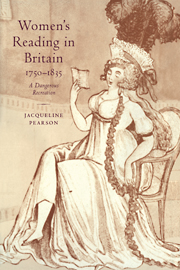Book contents
- Frontmatter
- Contents
- Preface
- Introduction
- 1 Pygmalionesses and the pencil under the petticoat: Richardson, Johnson and Byron
- 2 What should girls and women read?
- 3 The pleasures and perils of reading
- 4 Pleasures and perils of reading: some case histories
- 5 Where and how should women read?
- 6 Preparing for equality: class, gender, reading
- 7 A dangerous recreation: women and novel-reading
- Conclusion
- Notes
- Select bibliography
- Index
Introduction
Published online by Cambridge University Press: 22 October 2009
- Frontmatter
- Contents
- Preface
- Introduction
- 1 Pygmalionesses and the pencil under the petticoat: Richardson, Johnson and Byron
- 2 What should girls and women read?
- 3 The pleasures and perils of reading
- 4 Pleasures and perils of reading: some case histories
- 5 Where and how should women read?
- 6 Preparing for equality: class, gender, reading
- 7 A dangerous recreation: women and novel-reading
- Conclusion
- Notes
- Select bibliography
- Index
Summary
It is observed by Bacon, that ‘reading makes a full man, conversation a ready man, and writing an exact man’.
So Samuel Johnson (mis)quoted in 1753. But what kind of woman did reading make? From the 1750s to the 1830s culture, elite and popular, was preoccupied with such questions to an extraordinary degree. The reading woman became not only historical reality but also sign, with a bewildering range of significations. The period's most important debates, about authority, gender and sexuality, the economics and morality of consumption, national identity and stability, class and revolution, use the sign of the reading woman: and she might function as either positive or negative term. In British accounts of the French Revolution, conservatives registered support for traditional values by hagiographical accounts of Marie Antoinette reading with her children, or anxieties about social change through the image of a maidservant who dares to sit reading in the presence of her mistress. Those sympathetic to its aims depicted the importance of books for the emancipation of women ‘bastilled … for life’ in unjust social institutions, or used the difficulty of access to literature to symbolise the oppression of labouring-class women. Women's reading became ‘a site on which one may see a variety of cultural and sexual anxieties displayed’, even anxieties which do not seem primarily concerned with either gender or literacy.
‘Literacy was a part of the agenda for modernity, the city, and the Enlightenment’, and reading became ‘politicized as never before’.
- Type
- Chapter
- Information
- Women's Reading in Britain, 1750–1835A Dangerous Recreation, pp. 1 - 21Publisher: Cambridge University PressPrint publication year: 1999
- 1
- Cited by



